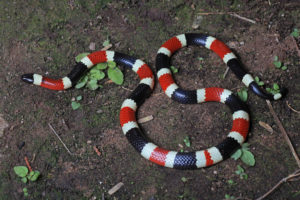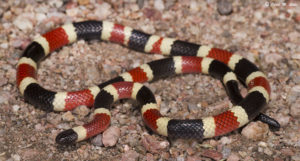Native to central Arizona down into southwestern Sinaloa, Mexico, the Sonoran Coralsnake (Micruroides euryxanthus) is comprised of three subspecies, with the Arizona Coralsnake (Micruroides e. euryxanthus) being the only subspecies located in the U.S. M.euryxanthus australis is found in Sonora, Mexico, and M.euryxanthus neglectus is found in Sinaloa, Mexico.
Several physical characteristics that differ from other American coralsnakes (Micrurus sp.) place the Sonoran coralsnake into its own unique genus, Micruroides. These differences include one pair of chinshields and 17 rows of dorsal scales (15 in Micrurus).

These small, venomous elapids (family Elapidae) average 11-24 inches (28–61 cm) long as adults, making them one of the smaller venomous snakes native to the U.S. The largest documented specimen was 61.5 cm (Babb et al. 1989). These colorful snakes are clad in broad, alternating rings of red and black separated by narrow rings of yellow or white. Markings encircle the body and become paler on the belly. The head is black to just behind the eyes. Head is small and blunt, with small beady black eyes that can be tough to make out. Scales are smooth. The body is somewhat flattened.
The first broad ring behind the head is red, whereas on the eastern and Texas coralsnakes the first band is black.
The Sonoran coralsnake is a dweller of arid and semi-arid habitat types including grassland, wooded areas, brush, thornscrub, farmland, and rocky upland desert along arroyos and river bottoms. Mostly nocturnal, these shy snakes spend most of their time hidden away in crevices, a lifestyle aided by their flattened body.
By night the Sonoran coralsnake searches the landscape for prey, which consists entirely of other reptiles: small lizards, and other snakes, including blindsnakes, groundsnakes, Nightsnakes, and ringnecks. Like all elapids, the Sonoran coral has fixed front fangs used to deliver a potent neurotoxic venom. Micruroides is considered to be less dangerous to humans than other coralsnakes. This is mostly due to their small size and equally small quantity of venom delivered in a bite. The few documented cases of human envenomation resulted in immediate pain, nausea, weakness, and drowsiness over the course of several hours. No human fatalities are documented.

Reproduction occurs in spring and 2 or 3 eggs are then laid in a crevice or underground chamber after heavy rains, July through September.
The Sonoran coralsnake is known for its dramatic defensive behavior: displaying its tail to distract from the vulnerable head while producing a sound using the cloaca, known as “cloacal popping” which is probably caused by expelling air from the intestinal tract (Bogert 1960, Young 1997).
Important points
- Coralsnakes do not attack or chase people, and spend most of their time out of sight.
- Coralsnakes do not need to “chew” to envenomate. Please refer to this article for more information.
- Simply leaving a coralsnake alone and watching it from a distance is all that is needed to avoid a bite.
- Coralsnakes are an important part of the ecosystem like any other wild animal and should simply be left alone.
Main article photo by Chad M. Lane, all photos used under the creative commons license
https://creativecommons.org/licenses/by-nc/2.0/